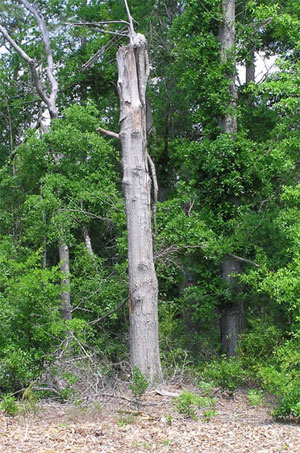Make A Resolution To Be More Wildlife Friendly
January 1, 2012
 The tradition of the New Year’s Resolutions dates back to 153 B.C. Janus, a mythical king of early Rome was said to have two faces which allowed him to look back on past events and forward to the future.
The tradition of the New Year’s Resolutions dates back to 153 B.C. Janus, a mythical king of early Rome was said to have two faces which allowed him to look back on past events and forward to the future.
The beginning of a new year is a great time to reflect on the issues of the past and resolve to do better in the upcoming year. The 2010 Gulf oil spill had a devastating impact on local wildlife. Florida is a state renowned for its diverse and unique ecosystems. But rapid development and environmental disasters, particularly in coastal areas, is continuing to destroy wildlife habitat. Resolve to be more wildlife-friendly in 2012 by following these easy tips from the Florida Yards and Neighborhoods Program.
Provide food
Select plants with seeds, fruit, foliage, or flowers that butterflies, birds, and other wildlife like to eat. Berries, fleshy fruits, nuts, and acorns are all treats for many animals.
Supply water
Any water you provide will attract wildlife. You could have running water in the form of a natural feature, such as a pond, creek, or other body of fresh water, but a fountain or birdbath will also beckon wildlife. Empty and clean your birdbath every few days. Do not clean it with soap or bleach—just physically scrub all surfaces with a brush or scouring-type sponge. Change the water regularly to prevent mosquito breeding and bacterial contamination.
Leave snags, which are the trunks of dead trees, in place if they do not create a hazard. Many birds use snags for perching, nesting, and feeding. Snags are often removed from yards or land mistakenly thought of as no longer having value. Nothing could be farther from the truth. A tree’s full life cycle at this point, is far from over.
Manage pets
If you permit pets to harass or kill wildlife, you will only hinder any efforts you make toward attracting wildlife. This is especially true for cats allowed outdoors.
Reduce insecticide use
Each time you apply an insecticide to your landscape, you reduce insect populations, which form an important food source for birds. Some chemicals can also poison birds and other animals that feed on affected insects.
Reduce the amount of mowed lawn area
Unmowed areas can contain more plant species than mowed areas, providing more potential food sources and habitat for wildlife. Reduce the mowed area around your house, especially in low-traffic areas, such as corners of the yard.
Increase vertical layering
Plant a variety of plants in different sizes and heights to provide more cover and feeding opportunities for diverse species of wildlife.
By following the simple tips in this chapter, your Florida-Friendly lawn and garden can become a sanctuary for wildlife, as well as part of a migratory passage between one wild space and another. Animals need to move from place to place, just like people. They have trouble traveling in heavily urban and suburban landscapes, but you can help them by joining your Florida-Friendly yard with others in the neighborhood to create a “natural corridor”—a safe, traversable route between woodlands, wetlands, or other wild areas.
For more specific information, visit the University of Florida/IFAS website at http://edis.ifas.ufl.edu/topic_landscaping_for_wildlife or call your local Extension Office.
Theresa Friday is the Residential Horticulture Extension Agent for Santa Rosa County.
Comments
6 Responses to “Make A Resolution To Be More Wildlife Friendly”




REGARDING:
“Reduce the amount of mowed lawn area”
Nobody does that better than I do.
David for mowing only enough to find vehicles
I resolve to not intentionally hit any deer with my Caravan, pickup or bus.
(and keep feeding the possum who comes on the front porch)
David the resolute
Compost fruit & veggie peels, coffee & tea grounds and filters, egg shells, most anything not cooked, not meat. Add your grass clippings & leaves. Turn under with a shovel. Water occasionally when very dry. This promotes less landfill waste, improved soil when compost decays, and worms love it. Then birds & other critters love the worms. And you have plenty fish bait when you need it. Composting is very environmentally friendly.
Northendvoter:You have my first laugh of 2012! I love your comment.Thanks. As for what I am doing to be more wldlife friendly here in the Colorado Mountains;the birds eat better than I do as I fill my 3 feeders every other day,I empty the frozen water dish every morning with fresh water,snags are left until I just have to have them for fire wood in order to not freeze to death,my dog only harrases the bears to keep them away from me and the house,there is no reason to use pesticides of any kind either inside or outside the house as bugs don’t live too freely at 10k foot elevation,of course grass doesn’t grow up here either,so no yard to mow,all I can do with vertical layering is stack rocks which give the chipmonks and squirrels more places to live!
I try to make my yard as wildlife friendly as possible. There is a spring in back, and I put out food for birds/other animals. I encourage lizards, geckos, frogs, and bats and fly catching birds to come into my yard and they are welcome to climb on the house to eat bugs, too! Just feeding and shooting deer is not considered helping the ecology!
My backyard is already wildlife friendly. I have a tri-pod with corn in it. Those deer love it. I only harvest the big rack bucks